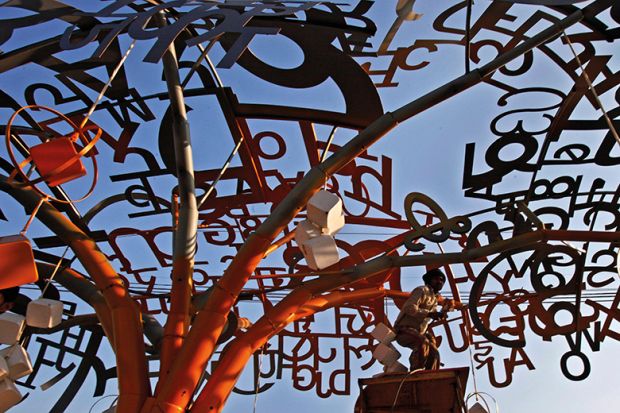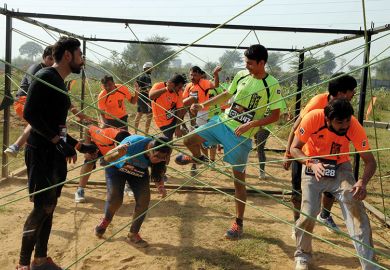Four years after the National Education Policy (NEP) was approved by India’s national government, its call for more education in the country’s indigenous languages has been heeded by one of its elite and previously English-only Indian Institutes of Technology, IIT Jodhpur.
The NEP recommends the wider use of regional languages as the primary medium of instruction both to enhance the status and vitality of India’s diverse linguistic heritage and to facilitate a smoother transition to the technical education environment for students from regional-language backgrounds.
Accordingly, 14 engineering colleges across eight states started offering courses in Hindi, Tamil, Telugu, Marathi and Bengali in 2021. But IIT Jodhpur’s move to offer undergraduate programmes in Hindi sets a new precedent within the IIT system, which other IITs, particularly in Hindi-speaking regions, are likely to follow.
While IITs may be government-controlled, they are not the right places for the government to experiment in this way. To date, minimal effort has been dedicated to translating academic content into Hindi and other Indian languages at the national level. This insufficient groundwork significantly hampers the feasibility of launching Hindi-medium – or any other language – instruction at a premier institution such as an IIT.
There are also specific problems with IIT Jodhpur’s move. Hindi is only one of the 22 official languages listed under the Eighth Schedule to the Indian Constitution. The central government hails this initiative as a step towards inclusivity but the risk is that it gives an unfair advantage to Hindi speakers.
Moreover, differentiating access risks lowering standards and creating a two-tier IIT system, compromising the global reputation of the whole IIT brand – especially among employers who recruit graduates straight out of higher education – known in India as campus placements. Apart from their high academic standards, IITs offer better job placements and higher salary packages for graduates compared with ordinary Indian engineering colleges. But a crucial factor in those prospects is IIT graduates’ English communication skills.
While mother tongue instruction can ease comprehension, effective communication, especially in English, is essential for graduates of prestigious institutions like IITs, who are expected to be prepared for global career opportunities. Those who graduate from regional language-medium programmes often face reduced access to skilled jobs and higher degree programmes, especially outside India.
Indeed, most engineering institutions in India recognise that poor English communication skills significantly hinder students’ academic performance and job prospects. Moreover, low English competency can impede institutions’ internationalisation efforts by limiting the number of faculty and students capable of engaging in global academic and professional networks.
IITs themselves have moved to address this issue over the past decade by offering specialised English-language modules and building state-of-the-art language laboratories.
Advocates of IIT Jodhpur’s initiative argue that using the same instructors for both Hindi- and English-medium engineering programmes will maintain educational consistency and quality. They propose offering students the choice between Hindi and English lectures, supplemented by translated textbooks and technological aids to ensure equal academic standards.
However, this dual requirement can be challenging to meet, especially where the pool of instructors fluent in both languages is limited. While IITs in Hindi-speaking areas such as Jodhpur may have plenty of faculty from a Hindi-language background, that is not the case with IITs in other regions, such as IIT Madras and IIT Palakkad.
Moreover, even Hindi-language engineering teaching materials are still scarce. The All India Council for Technical Education, which is responsible for the planning and coordinated development of technical education, already provides some books in regional languages but India has so far failed to invest heavily in translating and developing technical vocabulary in regional languages.
Effectively addressing India’s unique engineering challenges necessitates more than mere translation. It is important to adapt reference materials and books to local contexts to solve problems such as poor water management in urban and rural areas, bad waste management practices, heavy traffic and pollution, expensive healthcare, weak rural internet and costly farming machinery.
Hence, developing a comprehensive curriculum and textbooks in different native languages requires significant investment in developing educational resources – and training bilingual teachers proficient in using them.
Moreover, translation inevitably takes time, so translated materials rarely reflect the current state of the discipline. The few engineering books there are in Hindi certainly will not be helpful for IIT students with higher ambitions in cutting-edge research or further studies abroad. And translating the latest research within the IIT network would be time-consuming and costly, not least in terms of academic time that could otherwise be spent on advancing research.
Nor is it even clear that students would welcome such efforts. The government’s push for regional-language instruction comes at a time when demand for English-medium education is surging domestically given its importance in the job market. IIT Jodhpur’s move needs an urgent rethink.
Eldho Mathews serves as a programme officer (internationalisation of higher education) at the Kerala State Higher Education Council in India.
Register to continue
Why register?
- Registration is free and only takes a moment
- Once registered, you can read 3 articles a month
- Sign up for our newsletter
Subscribe
Or subscribe for unlimited access to:
- Unlimited access to news, views, insights & reviews
- Digital editions
- Digital access to THE’s university and college rankings analysis
Already registered or a current subscriber?








